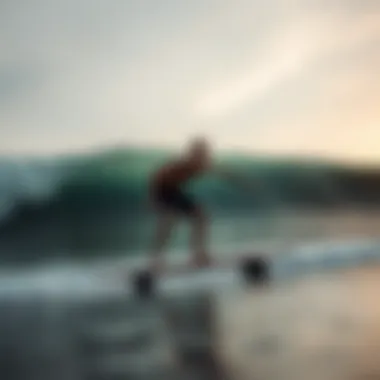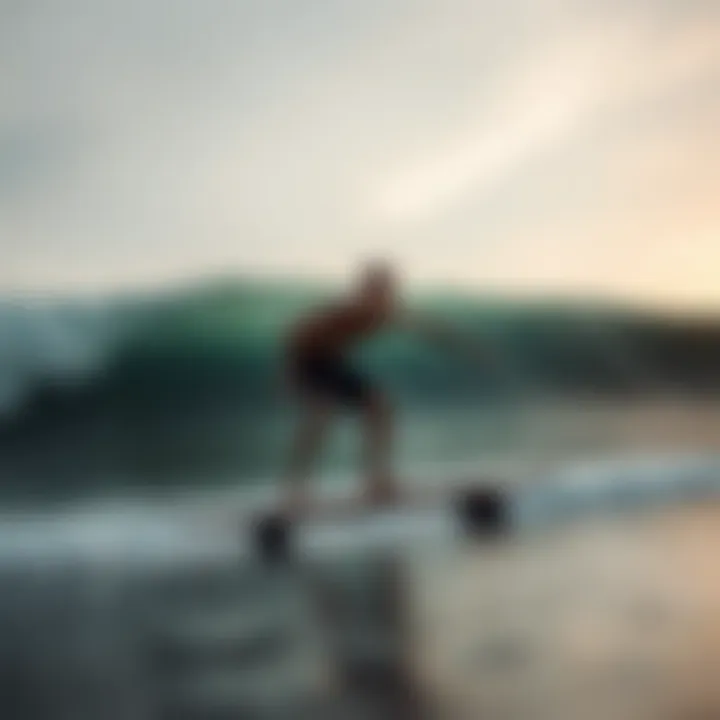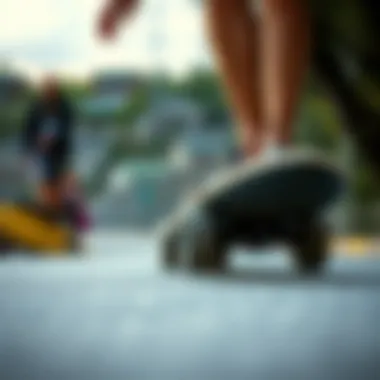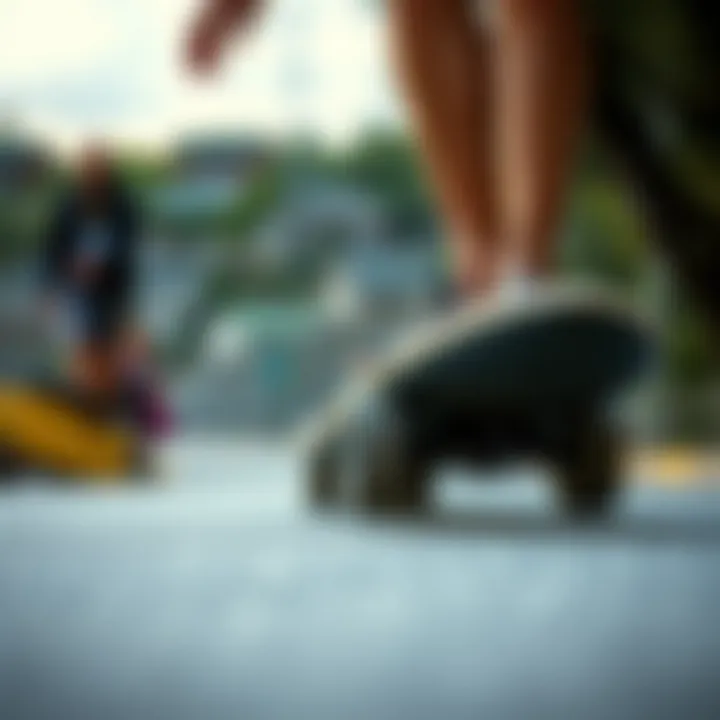Mastering Longboarding: The Ten Toes Technique


Intro
Longboarding has evolved into more than just a means of transportation; it’s become a vibrant culture, art form, and sport. Among its various styles and techniques, the ten toes method stands out for its unique balance and foot placement. This article dives into the heart of this method and aims to equip not only beginners but also seasoned longboarders with the knowledge necessary for an enriched riding experience.
The ten toes technique emphasizes having both feet positioned squarely on the board. This stance enhances stability and control, crucial for mastering various techniques. Riding is undeniably smoother when one has a firm grip on the board, allowing riders to navigate gentle hills or sharper turns with relative ease. With the wind in your hair and the pavement beneath you, longboarding can be a joyous pursuit, and having the right knowledge is your key to unlocking that joy.
As we journey through this guide, we will cover essential skills to grasp the ten toes stance, discuss types of longboards that suit different riding styles, and offer maintenance tips to keep your gear in top shape. We’ll also peek into the community aspect of longboarding, connecting you with fellow enthusiasts who share your passion. So whether you're just looking to cruise leisurely down the block or thinking of hitting the slopes, let's embark on this journey together.
Prelims to Longboarding
Longboarding has emerged as a captivating blend of sport and lifestyle, appealing to diverse groups—from surfers seeking a land-based shred to urban commuters looking for a smoother ride. The significance of longboarding goes beyond mere transportation; it embodies a culture that values freedom, creativity, and community. As we dive deeper into the nuances of longboarding, we'll specifically highlight the ten toes method, a technique that can elevate any rider's experience.
The ten toes technique focuses on positioning your feet, allowing an enhanced connection to the board and better control while cruising or carving. It brings distinct advantages, particularly for novices trying to find their footing, as well as seasoned longboarders looking to refine their skills. In our exploration, we'll dive into the intricate history of longboarding, tracing its roots back to the 1950s when surfing influenced its inception. This historical context not only enriches our understanding of the sport but also showcases how longboarding has evolved over the years.
Furthermore, understanding various riding styles is pivotal. Different techniques cater to distinct terrains, speeds, and individual preferences. For instance, a rider might lean towards carving when navigating tight streets or downhill racing for more adrenaline-pumping rides.
In summary, this introduction serves as a gateway into the world of longboarding, outlining the major areas we will explore while providing the reader with a framework to appreciate the ten toes stance. From its historical origins to the evolution of riding styles, every detail matters in enhancing the rider's experience and understanding of this thrilling sport.
History of Longboarding
The inception of longboarding traces back to the late 1950s in California, where surfers sought an alternative to riding waves during flat days. They crafted wooden boards with wheels, mimicking their surfing experience on land. This era marked the birth of skateboarding, bringing forth a culture that blended surfing with a new land-based adventure.
In those early days, many enthusiasts started what was known as "sidewalk surfing." The concept quickly gained popularity, evolving the instrument from simple wooden designs to more sophisticated models. By the 1970s, longboards spanned different lengths and designs, further shaping riding styles. The introduction of polyurethane wheels enhanced performance, allowing for smoother rides and greater stability.
Fast forward to the 1980s and 90s; longboarding began branching off into specific styles, with divisions such as downhill racing, cruising, and freestyle emerging. Each variant catered to different preferences, resulting in dedicated communities forming around them. The rise of skate parks further transformed longboarding, making it not just a means of transport but a fully-fledged hobby and sport.
Today, longboarding is more than just nostalgia; it encapsulates an entire lifestyle with its community driven by shared experiences and events. Iconic brands and shops foster growth by providing the latest gear, helping enthusiasts stay true to the roots while innovating for the future.
The Evolution of Riding Styles
Riding styles in longboarding have diversified dramatically, influenced by factors such as terrain, speed, and personal preference. To broadly categorize these styles, we can look at categories like cruising, carving, downhill racing, and freestyle tricks.
- Cruising: This style focuses on leisurely rides. Riders often explore their neighborhoods and parks, enjoying a relaxed pace. The emphasis lies on smooth rides and gliding over shorter asphalt areas.
- Carving: Embracing turns and rhythm, carving utilizes dynamic foot movements. Riders lean into turns, mimicking the motion of surfing, allowing for a flowy experience on the board.
- Downhill Racing: For adrenaline junkies, this style is all about speed. Riding downhill presents challenges as riders must manage speed and maintain control, pushing their limits to achieve the fastest times.
- Freestyle Tricks: Ultimately a creative outlet, freestyle riding combines techniques from various styles, allowing riders to experiment with tricks. This can include spins, flips, and other movements that showcase skill and personality.
The evolution reflects not only the changes in board design but also the growth of the longboarding community, as riders share experiences and techniques via forums and social media, fostering a sense of belonging. The advent of online platforms has further facilitated this sharing, creating accessible channels for beginners to learn and experts to refine their skills.
Longboarding today embodies a rich tapestry of history and diverse riding styles, reminding us how far it has come since those early days of sidewalk surfing.
Understanding the Ten Toes Stance
Longboarding can be as much about style and technique as it is about the actual ride. Among various riding styles, the ten toes stance is especially noteworthy. This method not only promotes balance but also opens the door to a multitude of skating styles and maneuvers. Understanding this stance is critical for both beginners and seasoned riders hoping to perfect their craft.
Defining the Ten Toes Technique
The ten toes stance is all about having both feet pointed directly forward on the longboard, with toes edging out towards the board's edges. It is sometimes referred to as the "regular stance" because riders often find this position more natural and intuitive. This setup allows for a more centered weight distribution, enhancing stability, especially at higher speeds.
Many riders opt for a narrow foot placement while utilizing this stance. This approach can dramatically affect turning radius, improving the rider's control over the board's maneuverability. One important factor to note is that the alignment of your knees and feet should be in sync; improper alignment can lead to discomfort or even injury over time.
Benefits of the Ten Toes Position
Adopting the ten toes stance comes with several advantages:
- Enhanced Stability: With your weight evenly distributed, it becomes easier to maintain balance, especially during turns or on uneven surfaces.
- Improved Control: Riders often find that steering feels more intuitive, allowing for sharper turns and better responsiveness to terrain changes.
- Ease of Transitions: Switching from riding to pushing or vice versa feels more seamless when you are aligned with this technique. This helps in different riding approaches like cruising or commuting.
- Less Strain on the Body: A well-structured stance can mitigate strain on the knees and ankles, prolonging the riding experience without discomfort.
Common Misconceptions
Many myths can cloud understanding around the ten toes stance. One prevalent misconception is that it is only suitable for beginners; however, this couldn't be farther from the truth.
"The ten toes technique is not just a stepping stone, it’s a foundation for riders of all levels."
Another belief is that this stance limits creativity in maneuvering. In reality, this position enables a wide range of movements—from downhill racing to freestyle tricks—as it naturally readies a rider for quick shifts in balance.
Lastly, some think that riders must adopt an overly rigid posture. While it's vital to maintain a firm stance, incorporating flexibility in the knees is just as crucial for shock absorption and overall ride comfort.
In summary, a solid grasp of the ten toes stance not only boosts confidence on the longboard but also elevates overall riding skills. Understanding its nuances can make a world of difference for anyone looking to hit the pavement with purpose.
For more information on longboarding techniques, check resources like Wikipedia or join conversations on platforms such as Reddit.


Essential Skills for Longboarding
Longboarding is more than just gliding down the street on a wooden board; it’s a blend of art and science requiring various skills to master. Essential skills are the backbone of any longboarding experience, particularly if you aim to adopt the ten toes technique effectively. These abilities not only enhance your overall performance but also contribute to your safety and enjoyment while riding.
To truly grasp the essence of longboarding, you should hone the following skills: balancing, turning and steering, and stopping. Each serves its unique purpose, which, when mastered, ensures that you navigate the longboarding terrain with confidence.
Balancing Techniques
Balancing is arguably the cornerstone of longboarding. Whether you’re carving down a hill or cruising through a park, a stable stance can make or break your experience.
- Foot Placement: Start by understanding the crucial aspects of foot positioning. Keep your feet shoulder-width apart on the board while ensuring that your knees are slightly bent. That bend serves as a damper against the surprises the road oftentimes throws your way.
- Center of Gravity: A low center of gravity is key. Lean slightly forward when cruising, and maintain a straight posture. A wobbly ride might throw you off your game, leading to falls and tumbles.
- Core Engagement: Utilize your core muscles. They aren’t just essential in hitting the gym; they stabilize your body as you ride. Tightening your core allows you to absorb shocks and maintain balance during sudden changes in speed or terrain.
This may sound a bit basic, but trust me, every shred of balance counts!
Turning and Steering Essentials
Excellent turning skills can elevate your longboarding experience. They provide the freedom to navigate curves, avoid obstacles, and engage in different riding styles.
- Carving: This style of turning involves shifting your weight from one foot to the other, creating an arc. The pivotal part is to initiate each turn by leaning toward the edge of the board.
- Kickturning: For sharper turns, such as navigating tight corners, kickturning is essential. This method consists of lifting the tail of your board off the ground using your back foot and pivoting in the desired direction.
- Speed Control: Remember, turning doesn’t have to be a risky maneuver. Harnessing speed through body positioning allows smooth transitions that maintain your balance.
Each rider may develop a unique style of turning, but you’ll find that implementing these fundamentals will help you feel more in control.
Stopping Methods
Knowing how to stop effectively is what distinguishes a skilled longboarder from a novice. Without proper stopping techniques, you may wind up backpedaling out of control or worse, in an accident.
- Foot Brake: One of the simplest methods involves dragging your back foot on the ground. This technique enables gradual deceleration; the key is to keep your weight centered as you slow down.
- Ghost Riding: A more advanced technique where you propel the board forward while stepping off to the side. This allows your board to coast until it naturally slows down.
- Sliding: For the more adventurous longboarders, sliding can be exhilarating. It involves dropping your weight on your back foot and using your front foot to initiate a slide, letting friction slow you down.
"To ride freely is to learn how to stop efficiently."
These methods provide a variety of options to suit any situation, so spend time practicing each one until it feels like second nature.
Mastering these essential skills sets a strong foundation for longboarding—a sport where each ride offers the promise of exploration and fun. As you continue to practice, stay open to learning and refining your abilities; it’s all part of the journey.
Types of Longboards
Understanding the different types of longboards is crucial as each type serves unique purposes and caters to specific riding styles or environments. Whether you're cruising down the street, racing downhill, or carving sharp turns, the right longboard enhances your riding experience. Selecting the appropriate type can significantly impact your comfort, performance, and enjoyment on the board. Let's explore the primary categories of longboards and their distinctive features.
Cruiser Longboards
Cruiser longboards are often the go-to choice for those looking to ride casually around town. Generally, they have a wider shape and softer wheels, making them ideal for carving through city streets or campus pathways. Their design promotes stability, which is especially helpful when cruising at slower speeds.
Key characteristics include:
- Deck Shape: Typically wider and more flexible, allowing for a comfortable riding stance. Some have an upward curve that helps with pushing off and balancing.
- Wheel Type: Soft wheels (often 78A to 83A durometer) provide a smoother ride over bumps and cracks, typical in urban environments.
- Length: Usually ranging from 28 to 42 inches, they offer ease of maneuverability and a relaxed ride.
These boards shine in low-speed environments, where you might want to ponder life while enjoying the breeze. Whether it's a trip to your local café or a jaunt in the park, cruiser longboards make for an effortless and enjoyable experience.
Downhill Boards
For those seeking adrenaline, downhill boards provide the thrills that come with speed. Engineered to handle high velocities, they feature a stiffer deck and precision hardware for optimal control. Riding downhill requires both skill and the right gear, as terrain and velocity create potential hazards.
Main elements of downhill boards include:
- Deck Construction: Typically made from sturdy materials such as bamboo or maple, allowing for less flex and more stability at high speeds.
- Wide Trucks: Enhance stability and control during tight turns while descending steep grades.
- Larger Wheels: Usually between 70mm to 90mm, these wheels, combined with a harder durometer, provide a fast and smooth ride, minimizing resistance while rolling.
Riders must have a firm grasp on techniques like tuck and foot braking, as safety plays a vital role. With the appropriate gear, downhill boards open pathways to exhilarating experiences down those iconic hills you’ve always wanted to conquer.
Freestyle and Carving Boards
Freestyle and carving boards combine elements from both cruising and downhill longboarding but allow for more trick-oriented riding. These boards are versatile, making them suitable for performing tricks, slides, and sharp turns. Riders find them appealing due to their nimbleness and responsiveness.
Consider the following features:
- Deck Flexibility: These boards often utilize a certain flex that enables technical tricks while maintaining great control during regular riding.
- Shape Variations: Styles can vary considerably, enabling riders to choose between symmetrical or asymmetrical designs, depending on their preference.
- Wheels: Average wheel durometers range between 83A and 87A, encouraging both speed and grip while performing maneuvers.
A major appeal of freestyle longboarding is the room for personal expression. Riders can truly make these boards their own through tricks, styles, and unique riding experiences.
"Choosing the right longboard isn't just about the type, but about what fits your personal style and riding goals."
In summation, different types of longboards cater to distinct riding styles, environments, and preferences. Being mindful of these variations will help you find a board that enhances your experience, whether you aim to glide effortlessly, race downhill, or showcase your tricks.
Choosing the Right Longboard Equipment
Choosing the right longboard equipment can be the linchpin for a satisfying ride. A longboard isn't just a piece of wood on wheels; it’s a finely-tuned extension of your body. Your performance greatly hinges on what you choose. The relationship between you and your board can turn a decent ride into an exhilarating experience, or one fraught with difficulty.


There are a myriad of factors to consider when picking longboard equipment, including your riding style, skill level, and even the geographical terrain you’ll be riding on. The right deck, wheels, and protective gear aren't merely accessories; they are essential components that can maximize safety and enhance performance.
Deck Materials and Shapes
The longboard deck is your primary platform. When selecting a deck, material and shape are paramount. Common materials include maple, bamboo, and fiberglass. Maple tends to be stiffer and is often favored by downhill riders for its durability. Bamboo, on the other hand, offers more flex, making it ideal for cruising and carving.
Deck shapes can vary significantly, influencing stability and ride comfort. Here are some common variants:
- Drop-through decks: Easier to push, great for beginners.
- Drop-down decks: Lowered center of gravity for downhill stability.
- Kicktail: Provides maneuverability, allowing for tricks and sharp turns.
Choosing the right shape and material can help enhance your riding experience, aligning your equipment with your style. It’s not just about looks; the right deck can give you confidence and control.
Wheels and Trucks Explained
Next to your deck, wheels and trucks play a critical role in how your longboard performs. The choice of wheels affects everything from speed to comfort. Softer wheels (measured in durometer) absorb bumps better and offer smoother rides over rough terrain. Conversely, harder wheels are designed for speed and sliding, although they can feel jarring on uneven surfaces.
When it comes to size, larger wheels roll over obstacles easier, making every ride more enjoyable; however, some riders prefer smaller wheels for tricks and tight corners.
The trucks are equally important. These metal components connect the wheels to the deck. Consider the following when selecting trucks:
- Width: Match the width of the trucks to your board.
- Material: Aluminum is lightweight but strong, while steel is heavier but durable.
- Kingpin position: Higher kingpin trucks are better for tricks but may be less stable at high speeds.
Protective Gear Recommendations
Safety should be top of mind when longboarding. The thrill can easily overshadow the risks involved, so proper protective gear cannot be an afterthought. Here’s a list of essentials to keep you safe:
- Helmet: A must-have for any longboarding journey. Opt for a certified helmet that fits snugly.
- Wrist guards: They protect your wrists in case of falls, a common occurrence even for seasoned riders.
- Knee and elbow pads: These absorb shock and prevent scrapes on hard surfaces.
- Gloves: Sliding gloves can give you extra grip and protect your hands.
Riding without the proper protective gear is like surfing without a leash: risky at best. Investing in quality gear is well worth the peace of mind it brings as you cruise down your favorite hills.
Remember, safety first! Your longboard might carry you on a wild adventure, but being prepared can ensure that such adventures are enjoyable and injury-free.
Maintenance and Care
Longboarding might seem like a leisurely pursuit, but the importance of regular maintenance and care cannot be overstated. Just like a surfer must keep their board in top condition to ride the perfect wave, a longboarder must ensure their ride is not just operable, but optimal. Not only does this prolong the life of your board, but it also enhances your performance and, more importantly, safety. Ignoring the upkeep can lead to wear and tear that might put a damper on your fun, or worse, lead to accidents due to malfunctioning equipment.
Regular Inspections
Conducting regular inspections of your longboard is akin to checking your oil in a car; it's all about preventing potential issues before they become major headaches. Here’s what to keep an eye on:
- Wheels: Look for cracks and flat spots. If they wear unevenly, it might be a sign that you need to adjust your truck's settings.
- Trucks: Ensure they aren’t too loose or too tight; striking a balance is crucial for stable rides. Inspect the bushings as well for any signs of degradation.
- Deck: Minor scratches are normal, but deep cuts can compromise the integrity of your board. Regularly check for any delamination that might suggest an impending break.
- Bolts and Screws: These little players can easily get loose over time. Check and tighten them to prevent mishaps.
"A well-maintained board feels like an extension of yourself; you don’t just ride it, you glide with it."
Cleaning Techniques
A simple wash can make all the difference in keeping your longboard in top shape. Dirt and grime can affect performance and increase wear and tear. Here are some handy tips:
- Use Mild Soap: For basic cleaning, a mixture of water and mild soap works wonders. Avoid harsh chemicals which can dull your board’s finish.
- Wheels: Remove your wheels to clean both the wheel and the area around the truck where dirt accumulates. A toothbrush can help reach those tricky spots.
- Deck: A soft cloth can wipe down the surface. If using grip tape, ensure you’re using a compliant method so as not to wreck its grip.
- Don’t Forget the Trucks: Sometimes, a bit of lubrication on the pivot points can help with turning ease. A few drops of oil can often work miracles.
Upgrading Components
As you advance in your longboarding journey, upgrading components might become more than just a desire; it can be a necessity. Here’s where to think about enhancements:
- Wheels: Upgrading to a softer wheel can provide more grip and comfort, especially if you ride on rough surfaces. Manufacturers like Bones and Orangatang offer quality options.
- Trucks: Consider a pair of precision trucks for improved handling. Caliber and Independent could be brands to explore for performance fades.
- Bushings: Swapping in better bushings can greatly affect your turning and overall stability. Softer bushings can feel smoother, while harder ones enable tighter turns.
- Bearings: Quality bearings can reduce friction and increase speed. Always ensure they are adequately lubricated and free of debris.
Remember, the objective of maintenance and care is not just to keep your board looking snazzy, but to ensure you're riding with confidence. A well-preserved longboard enhances the experience, ensuring you can enjoy every single cruise, carve, and downhill run without worry.
For more tips on longboard care, you might want to check out community discussions on platforms like Reddit or Facebook for shared experiences and innovative ideas.
Longboarding Safety Tips
Longboarding can be thrilling, offering riders the chance to glide smoothly across varied landscapes. However, it’s essential to balance this exhilaration with sound safety practices. Prioritizing safety not only protects you but enhances the overall longboarding experience. In this section, we’ll explore important aspects that every longboarder should consider to prevent mishaps while riding.
Understanding Terrain Risks
Navigating different terrains presents unique challenges. Hills, turns, and rough surfaces can influence how a rider controls their board. Being aware of the kind of terrain you’re skating on is crucial. Here are some factors to keep in mind:


- Surface Quality: Cracks and debris can cause a loss of balance. Always check for smooth pathways.
- Incline and Decline: Riding downhill can elevate speed uncontrollably. Riding uphill requires more effort, and you need to conserve power for the return trip.
- Environment Changes: Wet conditions, sand, or fallen leaves can transform a safe path into a slippery hazard. Adjust your riding technique accordingly.
Before you hit the road, take a moment to survey your surroundings. Familiarizing yourself with the terrain can make all the difference. In complex environments, like city streets or park trails, caution should always be your first instinct.
Proper Riding Etiquette
Respecting fellow riders and pedestrians is equally important for a safe riding environment. Here are some simple etiquettes to follow:
- Communicate: Use hand signals to indicate your moves. Whether you’re turning or stopping, let others know your intentions.
- Yield to Vehicles: Always give way to cars and bicycles. Longboards can be more agile, but remember they have less stopping power.
- Watch for Pedestrians: When passing people on sidewalks or paths, slow down and politely maneuver around them. A little courtesy goes a long way in making the sport enjoyable for everyone.
- Observe Speed Limits: Some areas have designated speed limits for boarders. Ignoring these can lead to accidents and disgruntled locals.
By practicing proper etiquette, longboarders can foster a friendly culture around this activity while staying safe.
Emergency Procedures
Even the most careful riders can find themselves in tricky situations. Knowing how to react can mitigate potential injuries. Here are some vital pointers:
- Stay Calm: Panicking can cloud your judgment during emergencies. Taking slow, deep breaths can help you regain composure.
- Know Basic First Aid: Familiarize yourself with dealing with common injuries like sprains or road rash. This knowledge equips you to act swiftly.
- Have a Plan: If you're out riding, ensure someone knows where you are, especially if you’re heading into remote areas.
- Emergency Contacts: Always carry a phone. In case of severe injuries, knowing whom to call can save valuable time and resources.
- Rehearse: Consider doing mock drills with friends to practice emergency response. Playing different scenarios can prepare you for real-world situations.
“In all aspects of life, preparation is key. It’s no different on a longboard.”
Longboarding can be a fantastic way to spend your time. However, understanding terrain risks, following proper etiquette, and having a plan for emergencies are essential for ensuring your safety. By applying these tips, you not only protect yourself but also contribute to the harmony of the longboarding community.
For more resources on longboarding safety, visit Safety Tips on Wikipedia or check out community discussions on Reddit's Longboarding community.
Building a Longboarding Community
Creating a vibrant longboarding community fosters not just camaraderie among riders, but also nurtures an environment of shared learning and support. A strong community can provide a collective voice that encourages more riders to embrace this activity, facilitating growth in both numbers and skills. When individuals come together, they can share tips, tricks, and experiences that deepen everyone's understanding of longboarding. Moreover, popularizing longboarding can lead to improved access to roads, parks, and facilities designed for such activities.
Joining Local Groups
Local longboarding groups are invaluable for both new and experienced riders. Joining these groups allows individuals to engage with others who share a similar passion, making it easier to learn techniques and styles, especially for those diving into the sport for the first time. Connecting with local enthusiasts can also offer safety in numbers, which is particularly important for beginners who might be apprehensive about venturing out alone.
In addition to camaraderie, local groups often organize meetups, helping riders to actively practice their skills together. It is exciting to share thrilling days at skate parks or contribute to community events. One might find that local groups also keep you abreast of nearby competitions or new trends in the longboarding culture.
Participating in Events
Engaging in local and regional events can enrich a longboarder’s experience significantly. Participating in events such as races, demonstrations, and competitions brings about several benefits:
- Skill Development: These events provide opportunities to learn from others' techniques and strategies.
- Networking: Meeting new people at events can help form friendships, leading to invitations for future rides or group activities.
- Exposure to Gear: Events often showcase the latest longboarding equipment, allowing you to explore new products and get opinions from others.
Moreover, some competitions also offer awards or prizes, creating an incentive for riders to showcase their skills. Local events can be found on platforms like Facebook or Meetup, helping you stay informed about what’s happening in your area.
Online Communities and Resources
In today’s digital age, online communities are a treasure trove of resources and knowledge for longboarders. Websites and forums like Reddit and specialized longboarding blogs feature discussions on a range of topics from gear recommendations to riding techniques. These forums can be especially useful for those who may not have access to a robust local community.
Social media platforms also provide an avenue for sharing experiences, tips, and riding videos. Hashtags like #Longboarding or #TenToes can connect you with riders worldwide, fostering an inclusive community around your favorite sport. Additionally, several YouTube channels offer in-depth tutorials and product reviews, helping riders to refine their skills or better understand their equipment.
Online resources from educational institutions can also present insights into the physics and safety aspects of longboarding, further equipping riders with knowledge to improve their riding.
Being part of a community—whether local or online—can be a game changer in the longboarding journey. It not only enhances your skills but also enriches the experience with support and friendship.
End
In wrapping up this detailed exploration of longboarding with the ten toes stance, we uncover the nuances that make this technique not just a method of riding, but a lifestyle choice that blends art, science, and community. Whether you're a beginner who’s just jumped on a board or an experienced rider looking to refine your skills, understanding the ten toes approach is vital for enhancing your overall riding experience.
Recap of Key Insights
The ten toes technique holds several distinct advantages. First and foremost, it promotes better balance and stability. By having both feet centered on the board, riders can distribute their weight evenly, which helps in handling various terrains. Additionally, this stance allows for more fluid movement when carving or turning, creating a seamless riding experience.
Several points stand out:
- Improved Control: Keeping your toes pointed along the board's length allows for quicker and more precise turns.
- Reduced Risk of Injury: Proper stance minimizes the chance of losing balance and rolling off, a common risk with less stable techniques.
- Enhanced Comfort: Many riders report that the ten toes technique keeps them more comfortable during long rides, allowing for extended sessions without undue strain.
"Riding should feel like an extension of yourself. Embracing the ten toes stance can lead to that kind of ride." - An avid longboarder
Encouragement for Continued Practice
As with any skill, the key to mastery in longboarding lies in consistent practice. Embrace the early moments, where wobbles and uncertainties are merely stepping stones to greatness. Everyone must start somewhere, and even the most proficient riders occasionally revisit the basics to refine their technique.
For those still finding their balance, it's a good idea to:
- Set Small Goals: Aim for incremental improvements. Perhaps try a longer ride or a cleaner turn each week.
- Join Local Riding Groups: Engage with fellow longboarders to share tips, tricks, and experiences. You’ll learn not just from competition but also from collaboration.
- Record Your Progress: Sometimes, taking video footage of your rides helps spot areas for improvement that might not be obvious during practice.
By keeping your dedication high and being open to learning, you’ll not only progress in your own skills but also become a part of a shared passion that connects riders across the globe. Refresh your technique, share experiences, and ride on!



